Walt Radovich
First Air Commandos in Burma

ALL IN A DAY'S WORK
BY CAPTAIN CORTEZ F. ENLOW, Jr., M.C.
Liberty Magazine, October 7, 1944
Now you got that straight? Head for Myitson and give the ferry there a good going over. We gotta knock the Japs out of there for sure. Then head for Tagaung and see what you can find. British Intelligence says there's a lot of traffic at the Irrawaddy crossing."
Lieutenant Temple Moore, the Intelligence officer of Phil Cochran's Air Commando force, was just completing the usual informal briefing of the six bomber crews when he spotted black-bearded Charlie Russhon of Los Angeles, the Commandos' photographer.
"You goin' along, Rush?"
"Might as well," Rush replied.
"In that case, Rad," Moore told the pilot, Walter Radovich, "you better take them over that Jap airdrome at Kawlin. I'd like some pictures of that place.
If they're buildin' up anything there, we'll do that next."
That's the way it started. Casual is the word for it. The Air Forces' work is packed with death, just as that day's work was to be. But nobody really thinks much about it.
This was to be no exploit which would make a saga like Bombs Over Berlin, or Bombs Over Tokyo, or We Bombed Ploesti. Those are the big jobs. The raid on Burma ahead of us that afternoon has its counterpart in a dozen places in the world every day. It was the sort of thing thousands of our fliers are doing again and again as they throw the full weight of our air power against our enemies.
The way Radovich said, "Hop in, Cort," he might have been inviting me to ride down to the corner for a drink. I hoisted myself into the forward compartment through the escape hatch in the belly of the B-25. I had expected to wear my chute during the entire trip. Instead, the crew chief took it and packed it neatly behind the pilot's seat. There were four chutes up forward in the bomber, but how we would have been able to extricate them and put them on in an emergency I'll never know.
There were four of us forward and three men in the section aft. Back there were the tail gunner, waist gunner and radioman, and "Rush," the ubiquitous "photo Joe." Forward were Radovich, our pilot from Los Angeles; Bill Burns, the unobtrusive, friendly navigator and cannoneer from Springfield, Illinois; and the crew chief, who, besides being flight engineer, was responsible for the turret guns which protected us from attack above. The only space left for a flight surgeon was-in the gun well. Standing there, I could see out either side.
The take-off was incredibly smooth. We were off the ground before I knew it. We began our steady climb over the wild-looking mountains which separate India and Burma. At one point we could see the dust of the trucks moving along the new mountain road to the Chindwin front. On our trip deep into Burma and back, these trucks were the only signs of life we saw. Yet, as we flew along, the six bombers, with the five Mustangs outside our formation and high above, I knew our approach was creating a commotion below.

Our first objective was the Japanese airfield at Kawlin. As Temple had said, we were to give Rush a chance to take his pictures, then shoot up anything we saw. It was important, because this was the day before our transports and gliders were to carry Wingate's Raiders in behind the enemy lines in Burma. The remainder of the formation waited upstairs while we went down for the pictures. But there wasn't a sign of life on the air installation, and the revetments were empty. We saved our ammunition.
When Rush had finished, we joined up and led off for Myitson, the ferry crossing supposed to be of some importance. I was tense and perspiring as we aimed our nose down toward the telltale junction in the Shweli River. As we approached we saw smoke rising. It appeared to come from small fires around the village. The five other bombers remained in formation about four miles away as Radovich took our lead ship down to 300 feet for a look around. We went up the river beyond the town, but there was not a sign of a ferryboat-nothing which might be worth while as a target. The fires suggested that someone had beaten us to the draw.
We could return with our bomb bays packed and our guns unfired-or search for targets of opportunity. Radovich, whose feather-trigger temper had earned him the nickname the Mad Chetnik-he was of Serbian extraction-would never think of going home without a fight. He led us west toward the broad expanse of the vital Irrawaddy. As we approached the river at about 1,000 feet, we spotted a line of rafts loaded with trucks and a double-decked steamer and a large barge unloading at Tagaung. To the statistical control people, perhaps, this wasn't a large enough target, but there was enough there to satisfy the urge to fire on the enemy which had been built up by the long trip out. Radovich signaled the formation for attack.
I expected to be terrified on my first treetop bombing attack. But now I can't recall having experienced any sensations at all during the raid itself. It was something like the stage fright that vanishes once the acting commences. Perhaps I should have been stirred by the sight of the houses flying into the air as we overshot the boats, but there was nothing personal about our savage onslaught. At such times the only thoughts in one's mind are: Will we hit those rafts down there? Can we sink that steamer, burn that barge?
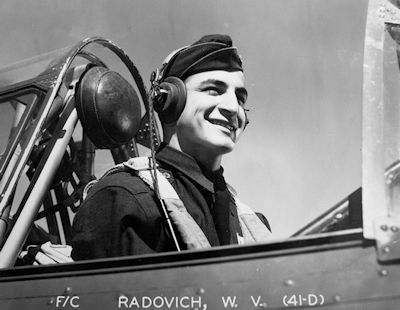
We had fallen into a long single file and our plane was the first to go in. We came screaming down out of a tight bank into a shallow dive and headed straight for the boat. I thought surely we were going to ram it. Suddenly the plane pulled up. As I started to rise from my kneeling position between the pilot and navigator I found I couldn't move. The shoulder straps supporting my camera, automatic, and binoculars pressed down on me as if someone were hanging on them. I was being held by the terrific centrifugal force of our tight pull-out.
When, finally, we leveled off and banked, I heard Radovich swearing at himself. He had been so intent on getting the bombers in attack formation that he had forgotten to turn the "bombsready" switch to the "on" position, and we'd dropped no bombs when he pressed the release button on the steering wheel.
The planes were making a wide circle like six huge buzzards, hovering over their prey. The circle dipped to within a few feet of the river on one side and rose to 1,000 feet on the far side. Each plane was dropping its bombs on the boats, but on the first time round, only one found its target. On our second attack we sent two 500-pounders through the camouflaged steamer and they exploded on the shore just at the water level, or so it appeared. It's only conjecture, because in a low-level attack things happen too fast for accurate observations. You fly by the target in a split second. All guns are blasting away, bombs are dropping, and the engines roaring as they put out every ounce of power. A man would have to be an extraordinarily cool observer to determine exactly how much damage was done.
All our bombs were expended in two runs and no one had seen any antiaircraft fire. Some of the rafts had disappeared and the town was on fire. Grant Mahoney, the imperturbable, boyish pursuit pilot from Oakland, California, had his Mustangs stooging around above us just in case some Zeros came along.
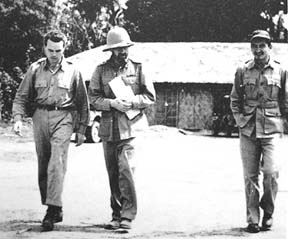
While walking through camp, Colonel Phil Cochran, Major General Orde Wingate and Major Walt Radovich discuss Operation Thursday in an impromptu meeting.
Who were Wingate and the First Air Commandos? See note below.
As the second phase of our raid began, I was busy grinding away with the movie camera. I had moved into the seat beside Rad. Bill Burns, the harassed navigator, had stepped into the gun well to become our "cannon walla" or cannoneer. We were rushing down on the ship and were nearly 1,000 yards away when there was a terrific explosion. At the same moment -a wall of brilliant orange flame appeared in front of us and we flew right through it. In another moment the cockpit was filled with the acrid stench of burned powder. Radovich had fired the 75-mm cannon in the nose of the ship.
The plane responded to the firing with a slight lurch and I could see our first shell hit the water. A miss. Burns, in the gun well, was sweating like a stoker as he rammed another shell into the breech. Rad quickly adjusted the gun sight atop the dashboard and there was another crashing noise. The second shell passed cleanly into the ship. and exploded. The last two shots of that run went high.
There are three buttons on the wheel of the B-25-H. One fires the cannon, another drops the bombs, and the third fires the six forward machine guns. In the few seconds it took Bill to reload, Radovich would rake the target with the 50-calibers. Inside they sounded like a violent hailstorm on a tin roof, even above the roar of the engines. Six streams of machine-gun shells would fly out ahead of us toward the boats, some leaving a trail of fire and others ribbons of smoke that we tore through.
Low-level bombing is the most dangerous type of aerial attack. The pilot, while he is dropping his bombs, firing his cannon, or shooting his machine guns, is also flying a huge airplane at great speed only a few feet above the treetops. To this, add the duties of a squadron leader directing the attack of all his other planes and you have a picture of a busy man. The slightest error in pilot judgment may mean death. Then add the dangers of ground fire at point-blank range, and of aerial attack in the most vulnerable position, and the total is the sum of all the dangers of combat flying.
As we flew in, our gunners in the top turret, at the waist, and in the tail were emptying their guns on the enemy. I could hear Rad screaming instructions and encouragement through his throat mike to the other bombers in the squadron-"Drive it home, Owen!" (Randy Owen of Nashville) "Drive it home! Good deal! Good deal! Think you got him."

Walt Radovich became a character in the Milton Caniff cartoon strip, "Terry and the Pirates."
|
Little Dan Sinski was driving his Mitchell in behind Owen. He began firing too far out. We could see him plainly as Rad racked the plane over on its left wingtip. Radovich yelled like a thirdbase coach: "For God's sake, Sinski, ride it in, ride it in! You were a mile wide." Then, to everyone, "Watch the pattern, sports. Tighten up, tighten up."
Murrell Dillard, a tall handsome blond boy from Eustis, Florida, was too eager to begin his attack. Rad yelled to him:, "You're starting too high, Dil. Get down, down!" As Dillard approached the target, tracers could be seen spitting from the tail of his plane. We knew "little Postie" one of the two Postlewait brothers of Manoa, Pennsylvania, in the outfit, was raking their path with his tail guns.
As we cleared the funnels of the ship by not more than ten feet and pulled up just in time to miss hitting the tall trees on the shore, the hazards of such wild flying never occurred to me. The barge flashed by; the burning ship raced under our nose; on each run the wall of green would loom up ahead and I could feel the blood leave my head as we climbed to clear it. In the excitement of the shelling and bombing you don't think much about these things. Pilots and crews are doing the same every day.
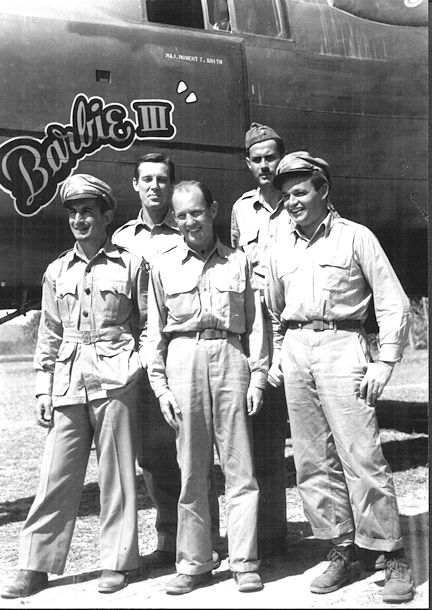
From left to right: Walt Radovich, A.E. 'Ole' Olson (ex-AVG), Col. John Alison (Co-Commander of the First Air Commandos), R.T. Smith (ex-AVG), Col. Phil Cochran (Commander) in front of B-25 Barbie III. Circa 1944.
But suddenly Grant Mahoney, who was watching the show from his Mustang above, screamed into the radio: "Rad look!" We looked back on the target in time to see a wing fly into the air and a rocket of yellow flames shoot up from just above the trees. It was Dillard, riding to death. The bomber careened as its tail section struck the trees. It seemed to come apart and fly into the sky. The broken plane skimmed along like a huge torpedo gone berserk. Now, with one wing and the tail section, with Little Postie in it, gone, it was on its back, and it plunged into the trees, searing a path through the jungle foliage for 200 yards. Suddenly it came to a stop and there was a violent explosion which sent a pillar of black smoke rolling up high above us. Then there was nothing but silent flame.
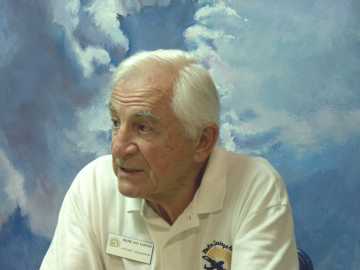
As if everyone hadn't seen it, Radovich, who felt his responsibility for his men keenly, kept calling: "That's our plane down there! That's no bomb burst-that's our plane down there!" We broke the pattern and headed down for the crash. We had made four passes at the target and with our pals down there below us there was no stomach for going on. Calmly Rad called the others through the throat microphone: "Rad to all planes. Re-form, fellows. Re-form. We're going home; we're going home. Over and off." He switched the radio off, turned and said only, "Nuts!"
We made two runs over the burning jungle. The trees were gone and the earth was scorched. At the end of the swath there was a fire. The Agatha, named for Dil's mother, was gone. The crew met death instantly, and that's the way Dil would have wanted it. In poker Murrell Dillard was a plunger. In training he always tried to outdo the other fellow. In his third run he had overshot because he pulled up too soon. I suspect that he drove his last attack home by riding his shells right into the target The trees on the bank came up in front of him too fast; he hauled back on the stick too quickly; the plane went into a high-speed stall; the right wing caught a tree, and handsome, friendly Dil and his crew "had it." No airman will ever criticize him because Dil was known as an "eager Joe." That's good enough for any pilot.
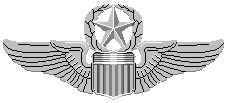
Wingate and the First Air Commandos
From "WINGATE'S RAIDERS," by Charles J. Rolo, Publ. By George G. Harrap & Co. Ltd. 1945 Second Printing. Pages 154-155
After agreeing on the broad outlines of a second Burma campaign Mr. Churchill said, "We are leaving to-morrow for a conference, and I should like you to be there." He then asked if Wingate had seen his wife yet. Wingate explained that she was, at that moment, in a train on the way south from Scotland. The Prime Minister reached for a telephone and gave instructions for the Scottish express to be stopped.
Later that night Mrs. Wingate was bundled off the train by plainclothes men from Scotland Yard, and rushed away in a fast car to an undisclosed port. Next day the Wingates, husband and wife, met for the first time since he left for Burma on a ship carrying the British delegation to Quebec.
Wingate's presence at Quebec remained secret, though it was hardly inconspicuous. Correspondents were never allowed to disclose the identity of the young brigadier who attended the conference in borrowed battle-dress-Wingate had found all the uniforms in his London flat eaten up by moths.
At Quebec, President Roosevelt and General George Marshall came under Wingate's spell. To them, and to Admiral Lord Louis Mountbatten, he outlined the ideas he had touched upon at his dinner with Mr. Churchill. At the conference a plan took shape.
A strong Long-range Penetration force of jungle-commandos commanded by Wingate would converge on the heart of the Japanese position in Northern Burma, and there establish a stranglehold on the enemy's network of communications. Such a move, if successful, would prevent the Japanese from bringing up supplies and reinforcements to their troops in the north, thus enabling General Joseph Stilwell to push ahead with construction of the Ledo Road, designed to open a new supply route into China. At the same time, by drawing Japanese strength inward, an expedition such as Wingate envisaged might create an opportunity for the Chinese on the Salween riverfront to drive into Burma and join hands with General Stilwell.
After the Quebec Conference, Wingate was invited to the United States, where he visited war factories, sampled the latest dehydrated foods, and inspected weapons and aircraft. General Marshall had promised that whatever he asked for would be shipped to India. Marshall was so impressed with Wingate's ideas on jungle warfare that he sent a force of picked American troops-many of them veterans of New Guinea and the Solomons-to be trained in Wingate's methods. This force, since known as "Merrill's Marauders " after its commander, Brigadier-General Frank Merrill, later won considerable fame for cutting to pieces in the Hukawng Valley a large part of the crack Japanese 18th Division, which had played a prominent role in the capture of Singapore.
The invasion scheme envisioned at Quebec called for the supply by air of no less than a full division of troops under Wingate, and the evacuation of all sick and wounded by air. It was also agreed that a small part of the force should be landed by air behind the Japanese lines. The creation of a special air arm integrated with Wingate's ground troops was actually suggested by Lord Louis Mountbatten. General Arnold enthusiastically endorsed the idea and promised that he himself would be responsible for the formation of such a force, which Arnold later named the Air Commando Force as a compliment to Lord Louis, then head of Britain's Combined Operations.
General Arnold brought this phase of the undertaking to Washington and sent for two young fighter pilots, Colonels Philip G. Cochran and John R. Alison. Cochran, aged thirty-four, who was appointed commander of the new jungle Air Commando unit, had behind him a brilliant record in the Tunisian campaign, in which his exploits had won him no fewer than five decorations. (He was, incidentally, probably best known as the real-life model for " Flip Corkin," hero of one of America's most popular comic strips, " Terry and the Pirates.") Alison, his deputy, aged thirty-one, had distinguished himself in the "Flying Tigers" under Major-General Claire L. Chennault. He wore the Distinguished Service Cross, the Distinguished Flying Cross, the Silver Star, and the Purple Heart, and had served for a time in 1941 as Assistant Military Attache in Moscow.
Arnold gave Cochran and Alison a completely free hand. His only direction to them was, "I want to see the United States Army Air Forces play a large part in Wingate's coming operations. In fact, I want to see you spearhead General Wingate's campaign this season in Burma." Then he added with a smile, "And to hell with paper work. Go out and fight!" Cochran and Alison took Arnold at his word and never committed their organization to paper.

|